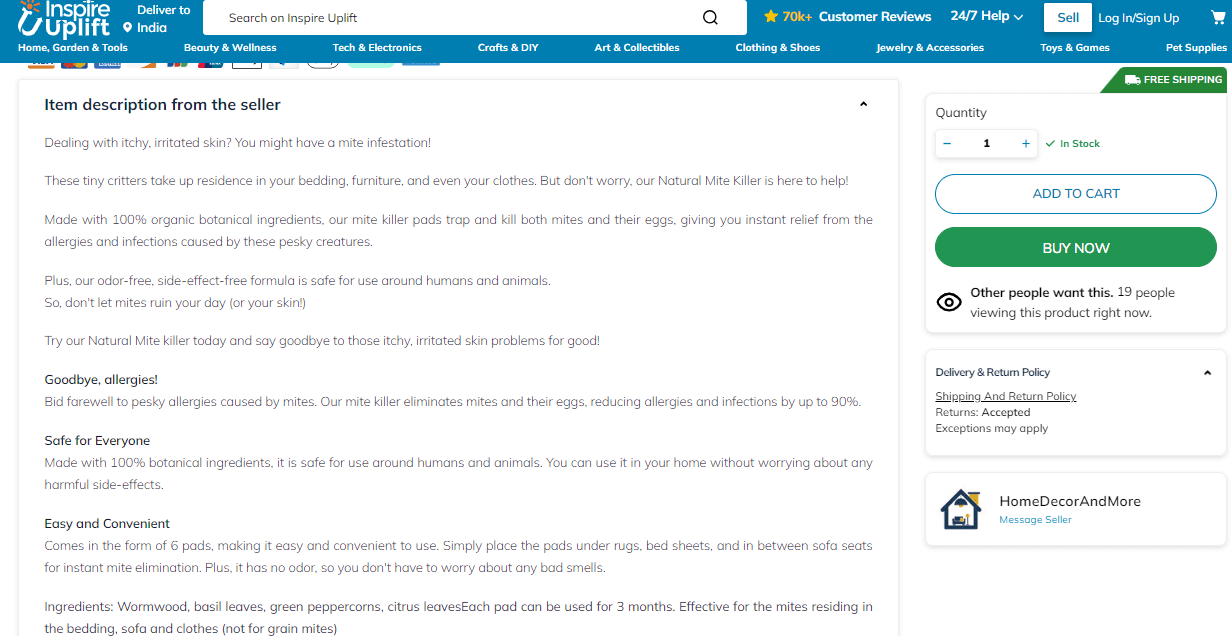In the ecommerce world, well-written product descriptions are key to success. They grab customer attention and increase the chances of sales. Beyond mere descriptors of your store’s items, they serve as powerful tools that captivate your audience and significantly boost your sales. So, the whole game is to showcase products using the best way to present their specifications.
This blog post is a guide for stores struggling with product descriptions. Covering basics to advanced tips, we aim to help you understand what makes successful stores’ items popular and conversion-worthy.
Find out how to get engaging, credible, clear, and persuasive product descriptions.
Role of Shopify Product Description in SEO
A product description tells its specifications, but apart from that, these also contribute to SEO. Let’s see how!
- As per a study, e-commerce sites with unique product descriptions have a 27% higher chance of ranking better in organic search results (source: Search Engine Journal). Therefore, it can be inferred that the description of the item sets the stage for higher conversion rates beyond visibility.
- An optimized product description positively impacts the search engine’s understanding. It lets crawlers relate products to a user’s search query and invite more qualified traffic for the store.
- If stores integrate SEO with them correctly while framing product descriptions, they can answer users’ questions more relevantly. It gives stores the opportunity to impress customers.
- Customers spend an average of 17.5% longer on Shopify stores that provide detailed and engaging product descriptions (source: Search Engine Land). Hence, the logical conclusion is that with information-rich descriptions, you can lower bounce rates and increase dwell time for your store.
You can reap all these benefits for your store if SEO is well-integrated while specifying your store’s items. Now, let’s see how to write SEO-friendly product descriptions.
Writing SEO-Friendly Product Descriptions
You can easily craft SEO-friendly product descriptions by following our suggestions. Our 12+ years of SEO experience for e-commerce stores enabled us to share this useful information.
Here are the tips:
- Keep it unique: Product descriptions should be unique, including titles. If there exist duplicate ones, search engines get confused and can’t decide what to do. However, you can add a “no index” meta tag to those pages as a solution.
- Add keywords naturally: Your descriptions secure a place in organic results when keywords are added naturally. It assures a flow and positive user experience when keywords are present in meta tags and headings.
- Avoid keyword stuffing: Target keyword inclusion is a must, but keyword stuffing in product descriptions can get you out of the race. It fails to persuade customers, as things sound artificial when forcefully added, so this practice should be strictly avoided.
- Highlight USP and keep the target audience in mind: People who are going to purchase from your store, need to understand product characteristics and unique selling points (USP). How you are different from your competitors defines you. So, keep the target audience in mind while highlighting USP in your product descriptions.
To get promising results, you can also read: How to increase sales on Shopify.
Keyword Research for Shopify Product Description
We will do a step-by-step walkthrough on how to write a Shopify product description in this article. Let’s start with keyword research first.
It begins with choosing the right SEO product keywords. You can use the “Refine by” section on Shopify to discover additional keyword ideas. Premium research tools such as SEMrush or Ahrefs can be highly effective. However, if you prefer free tools, Google Trends and Keyword Surfer are viable options.
By using these tools effectively, you can assess search volume and target audience. Generally, long-tail keywords tend to be more successful, whether included in blogs or product descriptions. The key is to insert them naturally, ensuring they maintain the overall flow.
Let’s make you understand this through our client’s example.
Tech Gadgets Dropshipping Store
Our client owned a dropshipping business store. They wanted to improve its visibility. While conducting keyword research for them, first, we used Shopify’s “Refine by” section and identified key terms like innovative gadgets, wireless accessories, and smart home devices.
We had keywords suggested by Shopify’s refine section, but Ahrefs gave us more clarity. Using the tool, we found that the “best smart home devices 2023” and “innovative trending technology” keywords were gaining more popularity.
So, we used these long-tail keywords in our client’s product descriptions and blog posts. This way, we aligned the interests of their tech-savvy audience and helped them achieve their goal of being in the top search results.
You can also add keywords along with products, popularly known as product tags. To know more about it, read Shopify product tags SEO.
Product Description Structure
Now, let’s explore the effective use of these keywords within the description. You can use these key terms to describe the product’s features, benefits, specifications, and usage instructions. If you are successful in describing so, there are higher chances of product sales, customer satisfaction, and brand reputation.
Follow the below-mentioned things to improve your product description structure:
1. Make it User-Friendly: While writing descriptions for your store’s products, aim to make the information as user-friendly as possible. For this, you have to put yourself in the shoes of your ideal buyers.
Address them directly, just like a gift-selling store, “Inspire Uplift” has done.

2. Use bullet points in the descriptions: As per a study, using bullet points in the product description increases readability and understanding by 43%, resulting in a higher conversion rate (source: Search Engine Land).
Here’s a great example of a product description from Gymshark. They have used bullet points to describe product benefits.

Focus on these areas while creating a product description:
- Make your headings catchy and unique.
- Easy-to-use bullet points in descriptions are a must.
- You can include plenty of white space while presenting information.
- Font size can be increased to promote readability.
- High-quality product images are the icing on the cake.
3. Including Technical Specifications and Dimensions: When a store adds technical detail to its product description, it succeeds in winning buyers’ confidence. But, remember to keep it optimum.
4. Create scannable content: Short paragraphs are easy to understand for viewers. Conversely, shoppers may not bother to read lengthy content. We always prioritize using lists when crafting descriptions for our client’s store.
Note: When composing product descriptions, remember that you’re writing for people, not just search engines. SEO and user behavior are interconnected and should be considered simultaneously as well.
Think of Product Descriptions as a Sales Copy
Another impactful product description approach is using persuasive language, just like in a sales copy. Provide factual information about the item while highlighting its features and specifications in a compelling manner.
We don’t want it to sound difficult for you. That’s why, sharing some easy-to-follow and proven suggestions:
- Use persuasive language and tone in the product description. It should be crafted like users get enticed to use the item after reading.
- If you write anything, rethink at least once if it contains abstract adjectives; it’s better to remove or replace them. Its inclusion disturbs the flow.
- You can incorporate powerful words to boost customers’ confidence, and they will think about purchasing the product.
- Ensure that the USP stands out without effort in the final copy.
Our advice will definitely help make your product descriptions engaging, credible, clear, concise, and persuasive. But, sometimes stores make silly mistakes that lead to losing viewer’s interest. In the next segment, we will share which mistakes you need to avoid.
Pitfalls to Avoid When Writing Shopify Product Descriptions
When you think you are done writing product descriptions, have one last run through this list to ensure your descriptions are perfect.
1. Neglecting keyword research: What would be the benefit of owning a high-quality products store, if your products couldn’t appear on your target audience’s device screen?
Keyword research helps you to be accessible. If neglected, there would be no use in writing impressive, creative and well-written product descriptions.
2. Copied Content: When plagiarized content is used in product descriptions, Google recognizes and marks it as duplicate. So, if you want your data to be crawled, avoid copied content.
3. Over-the-top Benefits: Present what exists in reality. Don’t exaggerate things, as this can cause negative feedback for your store, lowering your ranking in SERPs.
4. Grammatical errors: People skip products with typos, either in descriptions or titles. But, to avoid such errors, you can use tools like Grammarly or ChatGPT.
5. Inconsistent product descriptions: If users notice missing elements in your product description compared to other pages on the store, it may shake their trust, making them hesitant to make a purchase from a store with inconsistent product descriptions.
6. Over-optimized content: When using over-optimized product descriptions, there are chances you can get penalized as it diminishes the overall quality and effectiveness.
Conclusion
With all the information we’ve provided, you now have the essential details needed to create an SEO-optimized product description. Reading this article will contribute to improved rankings and conversions for your product.
Follow all these best practices to achieve overall success for your Shopify store. If you still require guidance or wish to have it implemented, consider hiring us. We can assist in creating either 20 or 2000 product item descriptions effectively and impressively.
FAQs
1. What is the ideal word count for a Shopify product description?
Ans. As per research, product descriptions with an average length of 300 words tend to rank higher on search engine results pages (SERPs). Try to keep your item’s specifications in this word count.
2. How to use long tail keywords in Shopify product descriptions?
Ans. After conducting keyword research using premium or free tools, you can get long-tail keywords. Use these key terms in your store’s product descriptions and register yourself in the top search engine results.
3. What are some free keyword research tools for Shopify store owners?
Ans. You can try Google Trends, Google Keyword Planner and Keyword Surfer for conducting keyword research. Use them and get key term ideas to include in your Shopify store’s product descriptions.
4. How to use images effectively along with Shopify product descriptions?
Ans. Present your products with high-quality images, showcasing various angles and accompanied by optimized Alt text. Implement a consistent style for your store’s images to ensure a unified look for the store. Well-crafted product descriptions will undoubtedly enhance the overall presentation alongside optimized images.
5. Should I use a Shopify product description generator?
Ans. If you have a large store selling many products, you can use the Shopify product description generator. It will give you content easily, but you need to customize generated content to set your products apart. You can achieve better results if you hire experts for this.
6. What role does storytelling play in Shopify product descriptions?
Ans. It’s really effective as one can create a relatable connection with their audience by storytelling in product descriptions. You can convey product benefits, increase user engagement, and ultimately drive sales for your store.

